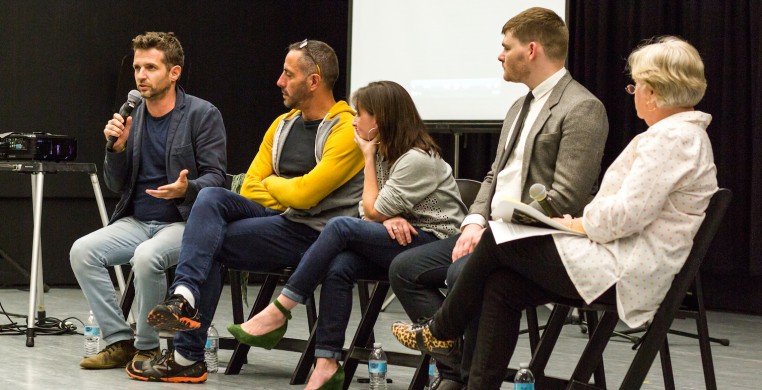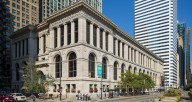A Cultural Exchange in Aesthetics
By Adam J. Greteman, Ph.D.
“Don’t think...feel.”
It’s a difficult thing to do...to simply feel without thinking. To feel the body, your body, move in space and time. To feel the temperature of the room, the strain of muscles, the movement of sweat as it falls from the brow to the floor. Your feet, your hands feeling the floor, feeling cloth next to your skin as you move across the floor to create something. Arms, legs, and heads - whole bodies - move to fill the space, feel the space, and occupy time. What is created, what is felt are not known. To know would be to think. And you are not to think...simply feel. And feeling is not simple.
In another installment of Audience Architect’s Moving Dialogs series, “Cultural Connections,” Bonnie Brooks, Joanna Rosenthal Read, Zachary Whittenburg, Niv Sheinfeld & Oren Laor danced amidst national borders to make connections between, within, and across “cultures.” They danced not physically, but as they spoke about and through their histories and ideas about dance as it connects (and perhaps disconnects) cultures. Sheinfeld and Laor are both contemporary Israeli choreographers working with Joanna Rosenthal Read, a contemporary American choreographer and artistic director of Same Planet Different World, on a collaborative project investigating the role, the challenges, and potential of cultural exchange. Less a political endeavor, however, their projects explore the crazy-ness of the world through aesthetics. What, the audience is allowed to ponder, does aesthetics bring to the table when people from various cultures meet, collide, and come to feel the needs of one another? Why are questions of the “aesthetic” necessary - vital even - in these crazy times?
As Sheinfeld noted during the dialogue, their work is “influenced and intrigued by people, their world, and what they bring.” Or put differently “people are our main thing.” Their focus on people - their dancers and what their dancers bring to the dance floor - shifts attention away from the traditional modes of dancers being choreographed by the choreographer toward a different mode where dancers work with the choreographers to create something yet unknown. “Don’t think...feel” becomes the challenging but central pedagogical and aesthetic strategy as dancers and choreographers feel together toward a finished piece. It is only after feeling toward that thinking begins to emerge as bodies are able to think through what has been felt.
The dialogue took place at the Chicago Cultural Center, which is simultaneously housing the Chicago Architecture Biennial. Beyond the walls of the dance studio, the audience had the opportunity to navigate, as they came to and left the dialogue, the international array of architectural concepts, ideas, and models that also address the pressing needs of the world. The aesthetics of dance met, at least momentarily, with the art of architecture to contemplate the international needs for a world. Structures that house people meet the people who make structures come alive with the needs and joys of the people who inhabit them. The architecture of the body met the architecture of space to show that cultural connections are always embedded in the complex worlds we inhabit.
There is little doubt that the world, its people, and cultures face any number of crises. From environmental degradation to scenes of police brutality to the plight of refugees fleeing war torn countries. People and their bodies - vulnerable to the political and environmental elements - struggle to survive and make sense of the world. Cultures, as such, continue to meet because bodies move across borders - sometimes welcomed and sometimes not. And how those bodies - bodies inhabited by people with hopes and fears, dreams and struggles - come to meet is of the utmost importance. The need for, the reality of, and the challenges encountered by cultural exchange are real. And dance offers one among many needed avenues for thinking and feeling through these crises as cultures meet.
Yet, culture as a concept, to draw on the title of Sheinfeld and Laor’s upcoming collaborative piece, is a vanishing point. We can in the midst of our own “culture” think it has disappeared; that we don’t have a culture. Yet, culture persists and often it is meeting people where we realize “culture” is always present. Such meetings are difficult as they require translations, awkward moments, and at times, lead to aggression. Yet, it is that process that is necessary in order to gain perspectives about one’s own culture and other cultures and perhaps new cultures established when cultures meet. The vanishing point - to return to that visual - is always there, in front of us, and no matter how hard we try it will persist. This is good as it provides us the opportunity to continue to do the work that needs to be done. We do not know what is there, in the future, but we can do things now to imagine that there is a “there” in the future.
The “there” in the future that the dialogue proposed is a future built on trust. The mode Sheinfeld and Laor engage in as choreographers is one dependent on building trust. They, with their dancers from Same Planet Different World, worked collaboratively to feel their bodies’ move and the dance form through those movements. This took time and engaging such a process in Israel and the United States. While time is “money” and time “flies,” it is engaging time, slowing time down, allowing things to unfurl in time that helps develop trust. This is not simply a task to get done, but a process to experience and experiment with in order to co-create something beautiful that does something for the dancers and the audience. Beauty here should not be reduced to its superficial qualities, but realized as a complex phenomenon that emerges as bodies, movement, music, and language come together to do something in the world. Beauty takes time to create, to feel, to understand. It stays with the audience and the feelings provoked move beyond the space of the dance to the space of our daily lives.
In a time when the world seems to be going at a breakneck speed as hyperlinks shift our attention from this to that, as apps remind us to do things, and the on-demand economy allows us to access goods, services, and people 24/7, the attention to process and time is perhaps a moment where Sheinfeld and Laor, and their dancers rebel. Rebellion is perhaps something from a bygone era. Yet, as Laor and Sheinfeld discussed in relation to their work in New York City - there remain all kinds of underground aesthetic practices that rebel against the “system.” And such rebellion is seen in their work by way of Janis Joplin whose music informs their process. Rebellion feels retro just as Janis Joplin’s music is quite retro. Yet, in a world - our world - where crises surround us it is perhaps a return to the retro concept and feelings of rebellion that are needed.
Cultural connections such as those created by the collaborations between Joanna Rosenthal Read, Niv Sheinfeld & Oren Laor provides an example of work that can be done. And their work, both in process and completed, rebels against ideas that some practices are limited to particular cultures. Rather, with grace and hospitality cultural practices are connected and engaged together in order to develop hybrid understandings of how, through dance, bodies come to feel different and allow an audience to feel different about the possibilities that exist within and between cultures.
The dialogue was by definition a conversation that happened between individuals sitting in chairs. The body, in such a set-up, takes a back seat - quite literally - to the spoken word. Bodies are always there, of course. An audience can see the panelists and their bodies. Yet, no dance took place. Instead, ideas about dance circled through the room. The only time dance was seen was when Laor and Sheinfeld provided two teasers for their works Cowboy and Two Room Apartment. And these teasers brought the filmed dance into the dialogue. These teasers, of course, did what they were supposed to do. They teased the audience, with filmed footage seen, however, through the lens of the camera. The dance captured, cut, and edited to do something else - to tease and entice potential audiences. The filmed teasers challenged the ephemerality of experiencing dance while also allowing a different ephemeral experience with dance. The moving bodies were seen - edited and filmed from different angles - to illustrate the power of dance, technology, and the bodies themselves.
And such teasers seemed quite appropriate to entice the audience to join the collaborative teamwork of Sheinfeld, Laor, Rosenthal Read, and the dancers of Same Planet Different World as they premier their work Vanishing Point at the Museum of Contemporary Art October 22nd-25th. In addition, Rosenthal Read will premier Stripped with the dancers of SPDW and Sheinfeld and Laor will re-create their Two Room Apartment.
Adam J. Greteman, Ph.D. is an instructor of Art Education at the School of the Art Institute of Chicago. His scholarship focuses on issues of gender and sexuality in education.


